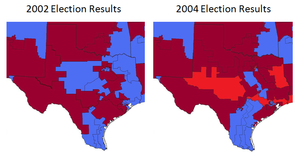
The 2003 Texas redistricting was a controversial intercensus state plan that defined new congressional districts. In the 2004 elections, this redistricting supported the Republicans taking a majority of Texas's federal House seats for the first time since Reconstruction. Democrats in both houses of the Texas Legislature staged walkouts, unsuccessfully trying to prevent the changes. Opponents challenged the plan in three suits, combined when the case went to the United States Supreme Court in League of United Latin American Citizens v. Perry (2006).
On June 28, 2006, the Supreme Court upheld the statewide redistricting as constitutional, with the exception of Texas's 23rd congressional district, which it held was racially gerrymandered in violation of Section 2 of the 1965 Voting Rights Act, apparently to try to protect a Hispanic Republican representative. A three-judge Federal District Court redrew District 23 and four other nearby districts: 15, 21, 25, and 28. In November 2006, a special election was held in the new districts. All incumbents won except in District 23. There, Republican incumbent Henry Bonilla was forced into a December run-off after a jungle primary; he lost to Democratic challenger Ciro Rodriguez.
